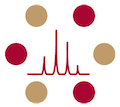2011 Stanford Mass Spectrometry Users' Meeting Lunchtime Seminar Abstracts

Lunchtime Seminars
| AB Sciex & Beckman Coulter |
Extending the Limits of Specificity and Throughput in Targeted Quantitative Proteomics using the TripleTOF™ 5600 SystemChristie L. Hunter, PhD - AB Sciex Interference in targeted quantitative assays comes from many sources, degrading the quality of quantitative data and ultimately quantification limits. Recent innovations in the TripleTOF 5600 System have enabled a new acquisition strategy, where looped MS/MS spectra are collected at high resolution, then fragment ions are extracted to generate high resolution MRM-like data, to provide higher specificity. The technique, termed MRMHR quantification, is sensitive and fast enough to enable quantitative performance similar to high end triple quadrupole instruments. In cases where there were interfering fragment ions, a significant improvement in LLOQ could be achieved by using higher resolution fragment ion extraction. To take multiplexing of targeted quantification to the next level, a more comprehensive workflow has been developed, MS/MSALL with SWATH Acquisition. Details and applications of these techniques will be discussed. An Introduction to CE-MSMass spectrometry (MS) has become an indispensable technology for the analysis of compounds of biological interest. Whether you seek to characterize a therapeutic protein; identify the proteins that make up a specific proteome; characterize post-translational modifications; study a metabolomic fingerprint related to a particular condition; or quantify drugs and their metabolites in a minute or complex sample matrix, improvements in assay sensitivity and reductions in ion suppression serve to reveal new information. To achieve this, we developed a new front-end separation-and ionization technology called CESI, which combines the high efficiency and ultralow flow characteristics of capillary electrophoresis with an integrated electrospray ionization source. |
| Agilent Technologies |
Simultaneous Determination of Metabolic Stability, Metabolite Identification and Profiling, Using the Agilent 6550 iFunnel Q-TOF LC/MS SystemYuqin Dai, PhD - Agilent Technologies Timely and rapid assessment of metabolic stability, metabolite identification and profiling is critical for accelerating lead optimization and enhancing the success rate of drug candidates entering into drug development. Triple quadrupole LC/MS instruments using multiple-reaction-monitoring (MRM) have been the workhorse for quantitative analysis such as metabolic stability and profiling. However, this platform is optimized for high sensitivity target quantitation and not well suited for non-targeted qualitative analysis. For these reasons, metabolite identification (qualitative) is often performed in a separate analysis on different types of mass spectrometers. Furthermore, due to the limitation of sensitivity on traditional tandem mass spectrometers, a relatively high substrate concentration (i.e.10-20 µM) is often required in order to identify metabolites with a broad coverage. The ability to obtain quantitation and identification in a single analysis makes metabolic stability, metabolite identification and profiling studies much more efficient. This also has the potential to increase assay productivity and decrease costs in drug discovery and development. In this presentation, an integrated Qual/Quan workflow will be discussed. The utility of the Agilent 6550 iFunnel Q-TOF LC/MS system for determination of metabolic stability, metabolite identification and profiling in a single experiment is demonstrated in the in vitro buspirone (1µM) metabolism study in rat liver microsomes. |
| Bruker Daltonics |
Bruker's Latest ESI-QqTOF and MALDI-TOF Innovations: Significantly Advancing Traditional Research CapabilitiesSandy Yates, PhD; Nannan Tao, PhD - Bruker Daltonics |
Many thanks to our meeting sponsors:
-
AB Sciex
-
Agilent Technologies
-
Beckman Coulter
-
Bruker Daltonics
-
Cell Signaling Technology, Inc.
-
Fisher Chemical
-
Perkin Elmer
-
Sage-N Research, Inc.
-
Thermo Scientific
-
VWR Scientific
-
Waters Corporation
